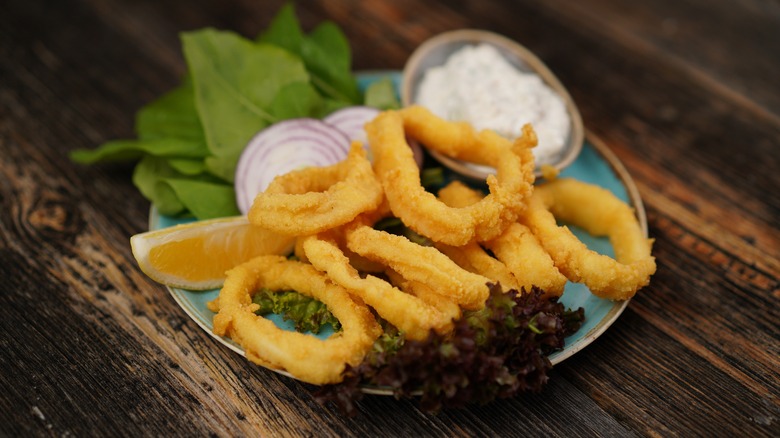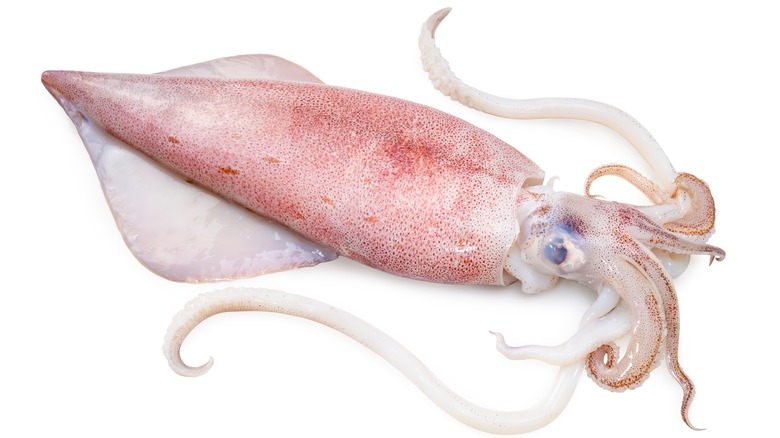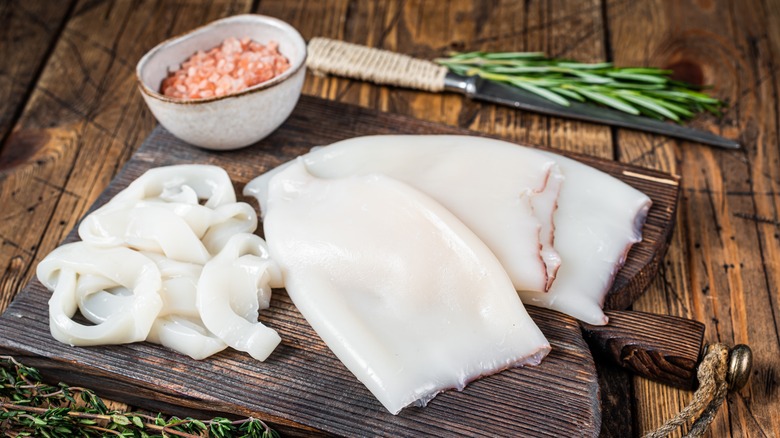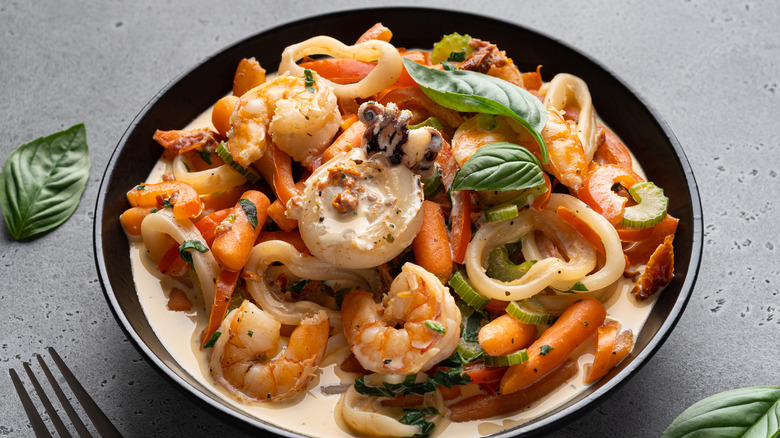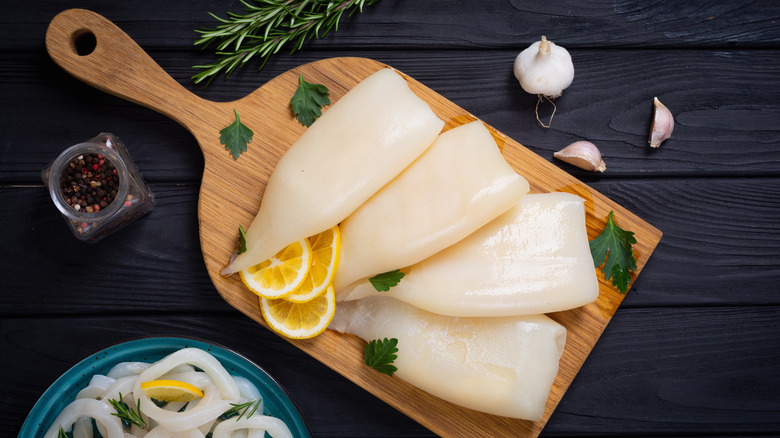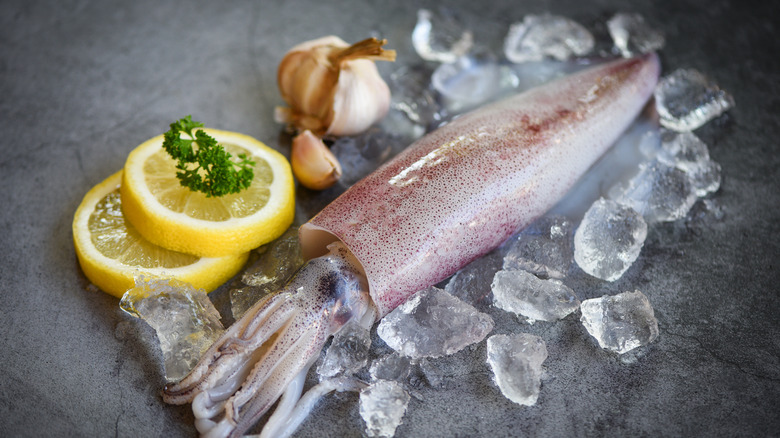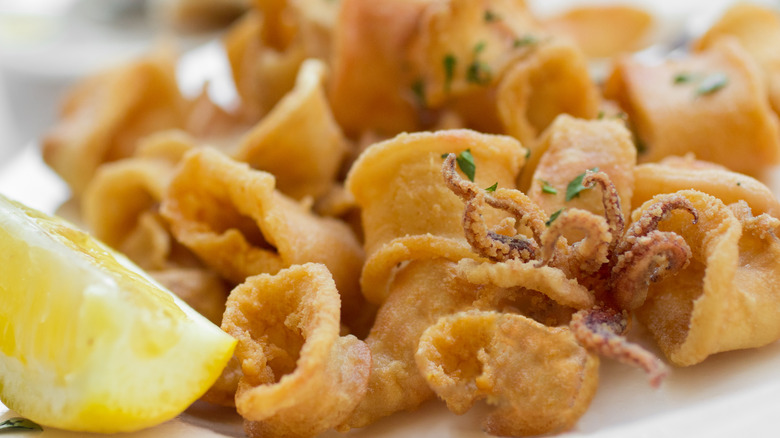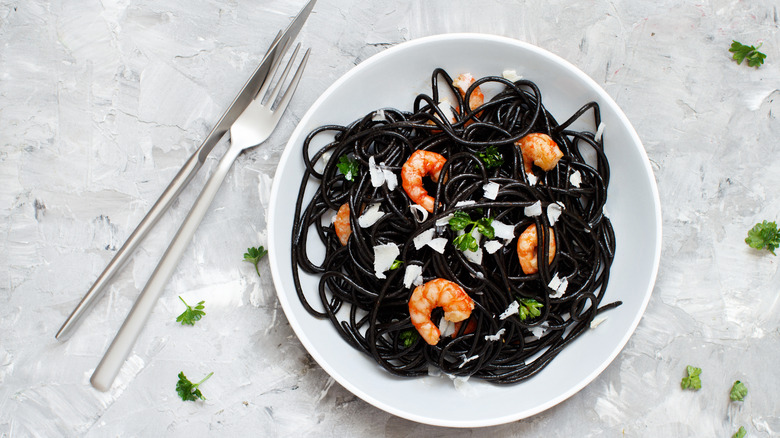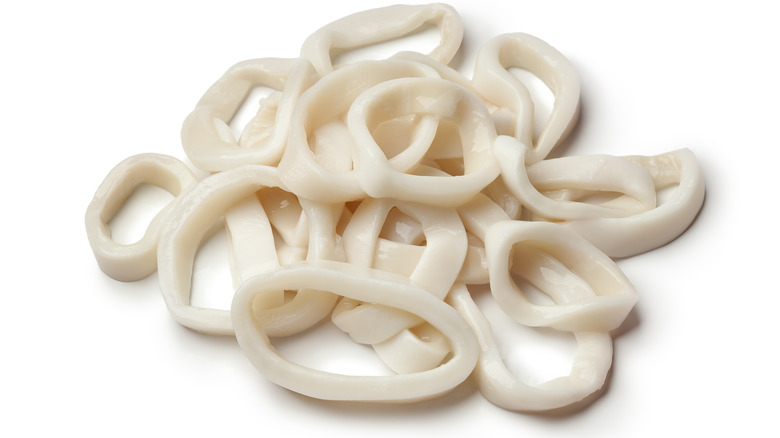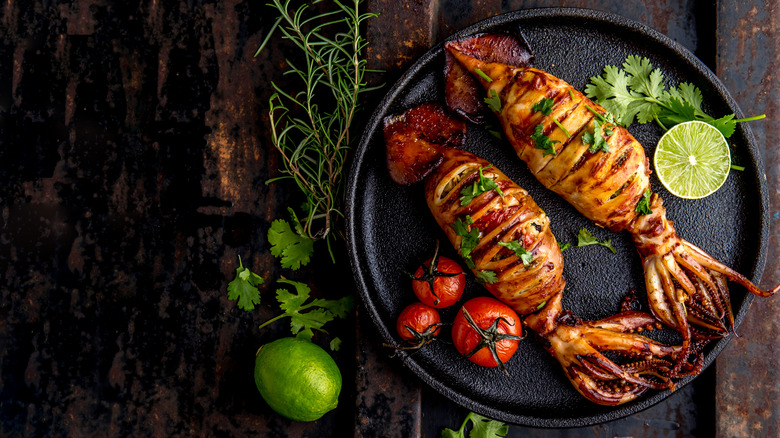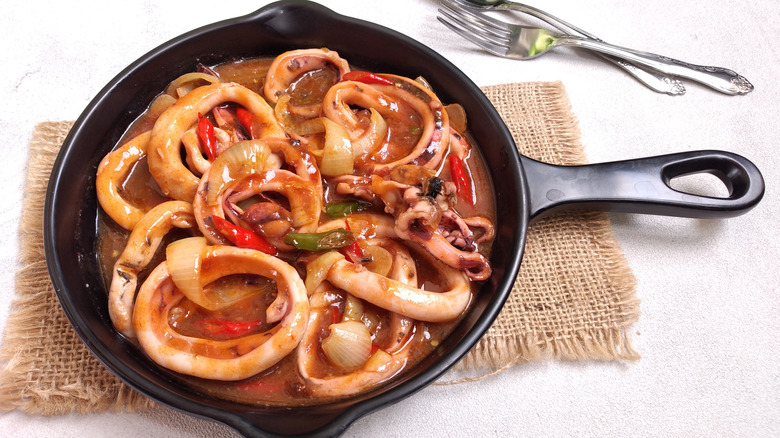Mistakes To Avoid When Cooking With Squid
For many seafood lovers, fried squid (otherwise known as calamari) is a go-to appetizer order when eating out, and serious seafood fans also look forward squid-ink pasta and stews with simmered squid at their favorite restaurants. But even seafood lovers who are experienced home cooks tend to avoid cooking squid at home, either because they've had bad experiences with it in the past, dread the fiddly chore of cleaning fresh squid, or because the idea just never occurred to them.
But if you're not cooking squid at home, you're missing out. Per Cooks Illustrated, it's both affordable and mildly flavored enough to appease the seafood adverse in your household. And if you're concerned about the environmental impact of eating wild-harvested squid, don't worry — according to Sea Forager, squid are among the most sustainable seafood, since they reproduce quickly and in large numbers. (And in case you're wondering, yes, squid and calamari are the same thing: While some use the term calamari to refer to a specific species of squid, per St. Louis magazine, most chefs and seafood purveyors use the terms interchangeably.) Cooking squid at home isn't difficult, but there are a few pitfalls you need to avoid — here's what you need to know.
Avoiding skin-on squid
If you don't work with fresh squid regularly, the idea of preparing it can be daunting. It can be hard to see the connection between a fresh whole squid — with its moist, mottled skin and suction-cup-covered tentacles — and the plate of crispy fried rings you're aiming for. And if the idea of cleaning and disassembling enough of the slippery critters to make a whole meal seems both messy and tedious, the idea of having to remove the skin from all of them can seem even more so.
But according to celebrity chef and cook Lidia Bastianich, there's no need to worry about this. If you're lucky enough to be able to access fresh, whole, skin-on squid (even most "fresh" squid sold in specialty seafood shops was flash-frozen after processing and thawed for sale, according to Cooks Illustrated), take advantage of it and go ahead and leave the skin on. Not only is it delicious, its red and white mottling gives you an easy way to tell if your squid is really fresh — if there's a strong contrast between the colors, your squid is fresh. But if the red and white seem to run together, this means the squid has been out of the water for a few days.
Settling for dull-looking squid
When shopping for any type of fresh seafood, it pays to do your due diligence. Just as you should inspect fresh fish to ensure they still have shiny eyes and a firm texture before buying, you should pay close attention to the squid you're considering before making your purchase. According to ABC, you should look for squid with shiny skin and an overall translucent look, avoiding any squid that look dull. "You want to make sure the calamari is firm and no slimy or and milky solution is present," Blake Hartley, executive chef at Lapeer Steak and Seafood in Atlanta, told Mashed.
If possible, you should also give fresh squid a sniff before buying it. "You should look for a nice sheen on the squid, a clean bright aroma (oceanic, not fishy)," chef Charlotte Langley, co-founder and chief culinary officer of the Canadian seafood purveyor Scout, told Mashed. And while you're pestering your fishmonger, go ahead and ask him or her to clean the squid for you if it passes your smell test and you decide to buy — this is a routine service for most seafood purveyors.
Overcooking — or undercooking — squid
Home cooks who do cook squid in their kitchens know it's a paradoxical beast. While most meats are cooked with a golden mean in mind (for instance, steaks should be neither overcooked nor undercooked), there's no such middle ground for squid. Per Great British Chefs, squid can only be cooked in one of two ways: very briefly at a high temperature (as for fried calamari and grilled squid) or low and slow for an hour or more (for soups and stews). Cook squid at what would seem a reasonable period for any other animal protein (say, 20 minutes or so), and you'll be stuck trying to chew through it for hours.
According to Cooks Illustrated, this paradoxical behavior is due to the muscle and collagen content in squid. When cooked quickly, the muscle doesn't have time to contract, so the meat remains tender. Cooked a bit longer, however, the muscle contracts while the meat loses moisture, resulting in toughness. But keep on cooking, and the collagen is converted into gelatin, which tenderizes and re-moisturizes the meat, making it pleasant to eat again.
Storing raw squid incorrectly
If you've gone to the trouble to buy fresh squid and have done the work to ensure you've purchased the freshest squid possible, it's critical that you treat it with respect after you get it home. Chances are, your squid will be given to you in a plastic bag — but according to ABC, you must resist the urge to just chuck that bag into your refrigerator. Instead, you should empty the bag into a colander and drain your squid well before putting it away.
And once you've drained your squid and are ready to store it, don't just put it in your refrigerator. According to Cooks Illustrated, it'll stay at its best if you store it in the back of the refrigerator (the coldest part) over a bed of ice. If you're planning on frying your squid (and thus want it as dry as possible), Blake Hartley, executive chef at Lapeer Steak and Seafood in Atlanta, has another recommendation: "It's best to store on a cheesecloth unwrapped on a cookie sheet. This will help to dry the surface area [to] maximize the consistency of the cook, and if you're flash frying, give you the right texture," he told Mashed. If you've purchased frozen squid (and per the Washington Post, there's no disgrace to that), just keep it in the freezer until you need it — because of its low moisture content, it withstands freezing well and can keep for a year without a loss in quality.
Avoiding frozen squid
Truly fresh squid is a treat — but unless you live in a coastal area with an active fishing fleet that does business with local sellers, you're unlikely to encounter it. "Most squid caught domestic is typically processed and individual quick frozen right out of the water," Blake Hartley, executive chef at Lapeer Steak and Seafood in Atlanta, Georgia, told Mashed. Thus, even the "fresh" squid you see on display at your fishmonger's is most likely thawed frozen squid, according to Cooks Illustrated. And Cooks Illustrated found that good-quality frozen squid tastes just fine and cooks up like fresh.
If you do see squid thawed in a fish case, ask how long it's been thawed to ensure the best quality. And if you do buy thawed squid, treat it and store it like fresh and cook it within two days. If you buy it frozen, it may come in a block. You can break off as much of the block as you need by hitting it against a counter. To thaw it for cooking, the Washington Post recommends putting the frozen block of squid in a bowl of cool water.
Cleaning your squid incorrectly
If you're fortunate enough to live in an area where fresh-off-the-boat squid is available, you should definitely take advantage of it — it'll not only be tasty, but affordable, according to Lidia Bastianich. In addition, prepping whole squid yourself gives you more control over your finished dish, since you can choose how big or small your pieces will be.
But there's no getting around it: Cleaning fresh squid requires care and attention. It's not technically difficult, but there are no shortcuts. According to Kirk Lombard at Sea Forager Seafood, you start with the optional steps of scraping off the skin and slicing off the squid's fins (both are edible, but are commonly removed for aesthetic purposes). Next, cut off the tentacles just below the eye and remove the squid's beak from the center of the tentacle cluster. It should pop right out. Then, using your fingers or a butter knife, remove the guts and quill (the strip of cartilage that forms the squid's spine) from the body. You can speed up this process by rinsing the bodies under a faucet. Once you get the hang of it, Lombard says you should be able to clean 2 ½ pounds of squid in 15 minutes.
Discarding the ink sacs
If you've ever cleaned whole squid yourself, you may have encountered a surprise — black ink squirting from the cut parts. You should think of this as a feature, not a bug. According to Instructables, squid ink is not only a valued ingredient in gourmet preparations such as squid-ink pasta and risotto, but its intense color also makes it a sought-after printing ink for artists.
To get the most ink possible from your squid, you need to be able to recognize and remove its ink sacs. Per Instructables, the squid's main ink sac is located in its body — when pulling the guts from the body, look for a long, silvery sac and set it in a nonporous ceramic, glass, or metal container. Smaller ink deposits can be found just behind the squid's eyes. To extract that ink, squeeze it from the cut end of the tentacle cluster into your container. To cook with the ink, pierce the ink sacs and dilute the ink with a small quantity of water — the ink is very concentrated, so slowly add more water if you think it needs it. Use immediately or keep refrigerated for a day or two — like the rest of the squid, the ink can go bad if kept too long.
Seeking out imported squid
It's common for high-end restaurants and ambitious home cooks to seek out luxurious imported ingredients for their tables – say, aged balsamic vinegars from Italy or Dover sole imported straight from the British Isles. But when it comes to squid, chefs and seafood purveyors agree that locally sourced options are always your best bet. "First and foremost, when purchasing you want to make sure you are buying domestic USA squid," Blake Hartley, executive chef at Lapeer Steak and Seafood in Atlanta told Mashed. "It's something that is already cheap. No need to purchase something from across the country."
And squid mavens around the world seem to agree that local is best. The Australian network ABC recommends that home cooks there seek out Australian-caught squid. But if a part of you still believes that U.S.-caught squid sounds like a cheap compromise, consider this: It was sought out by overseas buyers long before Americans started taking a liking to it. "American fishermen have always caught squid, but never got a good price for it," Jim Wallace, a marine resources specialist for the Sea Grant Cooperative Extension Service, told the Washington Post. According to the Post, the fishermen would freeze it on the spot and sell it to others fishing in the same waters — squid was popular with people from Spain, Italy, Portugal, and Japan.
Keeping squid in your refrigerator too long
There's an old maxim attributed to Benjamin Franklin that fish and visitors start to smell after three days. Unfortunately, the same holds for squid. Even if you've done all the right things — draining your squid before storing it and keeping it on ice in the coldest part of your refrigerator (as recommended by Cooks Illustrated) – fresh or thawed squid still has an extremely short shelf life.
"Use it before you lose it! When buying squid, plan to use it within two to three days of purchase to ensure maximum enjoyment," chef Charlotte Langley, co-founder and chief culinary officer of the Canadian seafood purveyor Scout, told Mashed. Fresher Pantry takes an even more cautious approach, giving raw squid a shelf life of only one or two days. (Cooked squid, however, can be safely kept three to four days.) But if your two or three days are up and you haven't had time to cook your squid, Langley has a practical solution. "If you are not able to enjoy [it] right away, slice [it] into rings and freeze in portions," she said.
Making the same squid dishes over and over
One possible reason not many home cooks have squid on their regular rotation is that only a tiny handful of squid dishes are commonly known to American diners. Besides the ubiquitous fried calamari (mostly likely too messy and/or smelly a project for home cooks with small kitchens or poor ventilation), there's the option of tossing squid into a pasta sauce or seafood stew. But tasty as these are, how much of these dishes can one possibly eat?
Dig a bit deeper, though, and you'll find your options will open up — a lot. For instance, if you have the time for a long-simmered squid dish, consider stuffed squid. As Mark Bittman observed in the Washington Post, the long, hollow bodies just beg to be stuffed. "You probably couldn't design a better food for that purpose," he writes. Per ABC, stir-frying and grilling are also great options for flash-cooked squid — and each marries well with a wide range of seasonings. And for a quick, easy at-home option, chef Charlotte Langley, co-founder and chief culinary officer of the Canadian seafood purveyor Scout, recommends squid escabeche. "[It] features cooked and blanched squid, chopped into bite-sized pieces, and mixed with crunchy, fresh vegetable[s] like cucumbers, tomatoes, celery, fennel, and fennel. Add a healthy serving of fresh herbs, a dash of vinegar of choice, and season to taste. Finish with a drizzle of olive oil," she told Mashed.
Thinking that all squid tastes alike
Not all squid are created equal. Per the Washington Post, they vary in shape and size, from tiny, bite-sized varieties to the giant squid native to Mexico with flesh so thick it's sold in the form of steaks. And while the exact variety of squid you purchase won't make a huge difference in the flavor of most preparations, if you really want to elevate your cooking or have a choice between fresh squid options, knowing the differences between the squid options available to you can be helpful.
The two basic types found in North America, according to the Washington Post, are the loligo squid (also known as longfin squid) and the illex squid (also known as shortfin squid). Loligo squid, at least on the east coast, has a sweeter, more delicate flavor than shortfin squid, according to The Town Dock, while shortfin squid has a more savory flavor and thicker flesh. Both types have dedicated fans, so if you can, try both to see which one you prefer.
